#hindu demigod
Explore tagged Tumblr posts
Text
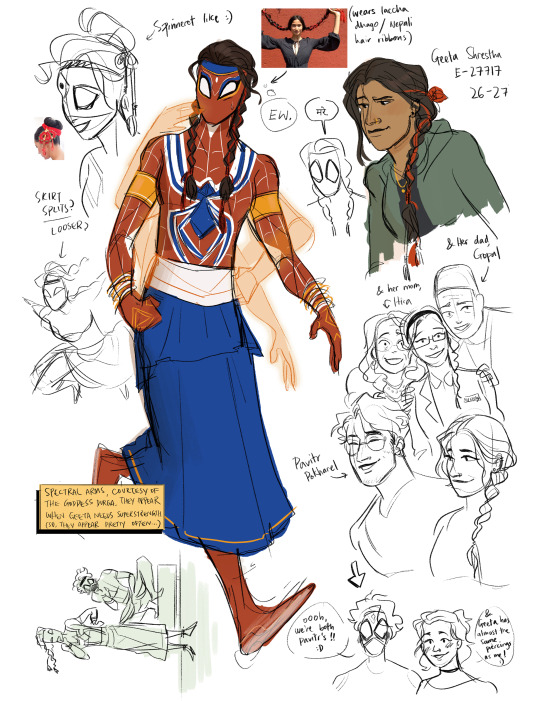

i deserve a spider-woman nepal..... miles doesn't have to be the only teen spider with a terrible bisexual mentor (enter my own sketches of the world's most annoying spiderperson, who i fling towards pavitr, complete with a design that's subject to change)
#geeta methodically puts on all her jewelery before going out as spiderwoman <3 u cant fight crime if u are not cute#spidersona#of sorts? i think but everyone should have expected this from me. there was no way sony was going to give me spiderman india#and not receive spiderwoman nepal (THE KATHMANHATTAN JOKE IS TOO EASY) in response#im tackling south asian unity one spidersona at a time!#pavitr prabhakar#spiderman#my art#also ofc one specific mention to demigod-of-the-agni who inadvertently triggered my actual posting of geeta#who was just supposed to stay in my psd files forever.....#mythic mumbattan au my beloved. hindu mythology my beloved. genuinely so so cool to see and it enabled me being self indulgent on this blog#for some extra context: im very much still workshopping her and me and my nepali friend were drawing her tgt#as in she would say something and i would hurriedly scribble/sketch it down#and then i kept kinda building on it. ofc i could not resist being inspired by the comics noirverse#so here she's also gifted her powers by a goddess (durga!!!!!) and almost works w her like a much less deranged moon knight. yeah...#don't look too closely at these pls . the design/sketching/etc is kind of everywhere#edit: forgot to adjust colors so theyre up again and a little more vibrant nyeow....
691 notes
·
View notes
Text
Adaptability of Mythology

When I took my first dedicated mythology class, my professor would talk a great deal about the “adaptability” of mythological practices and cultures, and how they grew and changed over time. At first, I didn’t really know what he was saying or really believed him, but then I started looking deeper and realized the truth behind what he said.
Take our media. Our books, movies, video games, etc., that are based in mythology. They’re filled with the romanticism and mystique of superheroes and caped crusaders. You can see it in their actions, in their mannerisms, in their personalities and backstories and, most of all, their powers. It’s not immediately visible, but once you see it, it’s hard to unsee.
For example, take the Rick Riordan books. In Greco-Roman or Nordic myth, demigods never really had special powers. In fact, most demigods in Nordic myth didn’t really have any powers, while in Greco-Roman myths, the powers of demigods and heroes tended to just be superhuman characteristics like speed, strength, intellect, etc., and almost never really relating to the domain of the demigod’s divine parents. Of course, in both Greco-Roman and Nordic myths there were exceptions, but the general case was as I described above.
But in Rick Riordan’s books, as well as other media, they all have powers based off the domain of the divine parent. When you consider superheroes, doing this actually makes a lot of sense. See, arguably, the biggest part of superheroes are their powers and mystique, and more specifically, the “genetic” component of that. Powers and mystique are passed down through generations, like Superman and his sons, or Batman and his Robins. The same thing happens with these books and media based of mythology, in which the powers and mystique of the specific gods are being passed down to their children in this way, giving them specific powers based off their divine ancestor.
You may wonder why superheroes, but I feel the answer becomes apparent when you look at the history of the West. After WWI, superheroes became incredibly popular. They were used a lot during the Great Depression, they were used as a recruitment tactic by the US and Allied Forces during WWII, they were used after WWII as a method to show just how amazing capitalist countries were, etc.
Even in more modern times, superheroes have still played a big role, despite people who read comics being called “nerds” and ridiculed for a good 20+ years, from the 80s onwards. They’ve just become a huge part of our culture, no matter what anyone says, for better or for worse. Hell, even kids who have never once picked up a comic-book obsess over superheroes like Batman, Superman, Spider-Man, etc. Thus, I don’t think it’s any coincidence that we choose to reshape mythology in this way.
Sorry for the long-winded and maybe difficult to understand rant, just thought it’s really interesting. Have a great day y’all!
#mythology#greek gods#greek pantheon#greek mythology#hinduism#hindu mythology#norse mythology#norse gods#norse deities#demigod#demigods#smythologies#rants#rants n rambles#superhero#superheroes#superpower#super powers#comics#theory#thoughts
39 notes
·
View notes
Text
Did People Really Live Hundreds Of Years?
Dale Pollard (Genesis 5) Genesis records those who lived for hundreds of years and it’s nearly unbelievable for some people and for others— it is. Look at some examples from Genesis chapter five: V.17 “Thus all the days of Mahalalel were 895 years, and he died.” V.20 “Thus all the days of Jared were 962 years, and he died” V.27 “Thus all the days of Methuselah were 969 years, and he…

View On WordPress
0 notes
Text
Sri Lankan Fairies and Senegalese Goddesses: Mixing Mythology as a Mixed Creator
[Note: this archive ask was submitted before the Masterpost rules took effect in 2023. The ask has been abridged for clarity.]
@reydjarinkenobi asked:
Hi, I’m half Sri Lankan/half white Australian, second gen immigrant though my mum moved when she was a kid. My main character for my story is a mixed demigod/fae. [...] Her bio mum is essentially a Scottish/Sri Lankan fairy and her other bio mum (goddess) is a goddess of my own creation, Nettamaar, who’s name is derived from [...] Wolof words [...]. The community of mages that she presided over is from the South Eastern region of Senegal [...] In the beginning years of European imperialism, the goddess basically protected them through magic and by blessing a set of triplets effectively cutting them off from the outside world for a few centuries [...] I was unable to find a goddess that fit the story I wanted to tell [...] and also couldn’t find much information on the internet for local gods, which is why I have created my own. I know that the gods in Hinduism do sort of fit into [the story] but my Sri Lankan side is Christian and I don’t feel comfortable representing the Hindu gods in the way that I will be this goddess [...]. I wanted to know if any aspect of the community’s history is problematic as well as if I should continue looking further to try and find an African deity that matched my narrative needs? I was also worried that having a mixed main character who’s specifically half black would present problems as I can’t truly understand the black experience. I plan on getting mixed and black sensitivity readers once I finish my drafts [...] I do take jabs at white supremacy and imperialism and I I am planning to reflect my feelings of growing up not immersed in your own culture and feeling overwhelmed with what you don’t know when you get older [...]. I’m sorry for the long ask but I don’t really have anyone to talk to about writing and I’m quite worried about my story coming across as insensitive or problematic because of cultural history that I am not educated enough in.
Reconciliation Requires Research
First off: how close is this world’s history to our own, omitting the magic? If you’re aiming for it to be essentially parallel, I would keep in mind that Senegal was affected by the spread of Islam before the Europeans arrived, and most people there are Muslim, albeit with Wolof and other influences.
About your Scottish/Sri Lankan fairy character: I’ll point you to this previous post on Magical humanoid worldbuilding, Desi fairies as well as this previous post on Characterization for South Asian-coded characters for some of our commentary on South Asian ‘fae’. Since she is also Scottish, the concept can tie back to the Celtic ideas of the fae.
However, reconciliation of both sides of her background can be tricky. Do you plan on including specific Sri Lankan mythos into her heritage? I would tread carefully with it, if you plan to do so. Not every polytheistic culture will have similar analogues that you can pull from.
To put it plainly, if you’re worried about not knowing enough of the cultural histories, seek out people who have those backgrounds and talk to them about it. Do your research thoroughly: find resources that come from those cultures and read carefully about the mythos that you plan to incorporate. Look for specificity when you reach out to sensitivity readers and try to find sources that go beyond a surface-level analysis of the cultures you’re looking to portray.
~ Abhaya
I see you are drawing on Gaelic lore for your storytelling. Abhaya has given you good links to discussions we’ve had at WWC and the potential blindspots in assuming, relative to monotheistic religions like Christianity, that all polytheistic and pluralistic lore is similar to Gaelic folklore. Fae are one kind of folklore. There are many others. Consider:
Is it compatible? Are Fae compatible with the Senegalese folklore you are utilizing?
Is it specific? What ethnic/religious groups in Senegal are you drawing from?
Is it suitable? Are there more appropriate cultures for the type of lore you wish to create?
Remember, Senegalese is a national designation, not an ethnic one, and certainly not a designation that will inform you with respect to religious traditions. But more importantly:
...Research Requires Reconciliation
My question is why choose Senegal when your own heritage offers so much room for exploration? This isn’t to say I believe a half Sri-Lankan person shouldn’t utilize Senegalese folklore in their coding or vice-versa, but, to put it bluntly, you don’t seem very comfortable with your heritage. Religions can change, but not everything cultural changes when this happens. I think your relationship with your mother’s side’s culture offers valuable insight to how to tackle the above, and I’ll explain why.
I myself am biracial and bicultural, and I had to know a lot about my own background before I was confident using other cultures in my writing. I had to understand my own identity—what elements from my background I wished to prioritize and what I wished to jettison. Only then was I able to think about how my work would resonate with a person from the relevant background, what to be mindful of, and where my blindspots would interfere.
I echo Abhaya’s recommendation for much, much more research, but also include my own personal recommendation for greater self-exploration. I strongly believe the better one knows oneself, the better they can create. It is presumptuous for me to assume, but your ask’s phrasing, the outlined plot and its themes all convey a lack of confidence in your mixed identity that may interfere with confidence when researching and world-building. I’m not saying give up on this story, but if anxiety on respectful representation is a large barrier for you at the moment, this story may be a good candidate for a personal project to keep to yourself until you feel more ready.
(See similar asker concerns here: Running Commentary: What is “ok to do” in Mixed-Culture Supernatural Fiction, here: Representing Biracial Black South American Experiences and here: Am I fetishizing my Japanese character?)
- Marika.
Start More Freely with Easy Mode
Question: Why not make a complete high-fantasy universe, with no need of establishing clear real-world parallels in the text? It gives you plenty of leg room to incorporate pluralistic, multicultural mythos + folklore into the same story without excessive sweating about historically accurate worldbuilding.
It's not a *foolproof* method; even subtly coded multicultural fantasy societies like Avatar or the Grishaverse exhibit certain harmful tropes. I also don't know if you are aiming for low vs high fantasy, or the degree of your reliance on real world culture / religion / identity cues.
But don't you think it's far easier for this fantasy project to not have the additional burden of historical accuracy in the worldbuilding? Not only because I agree with Mod Marika that perhaps you seem hesitant about the identity aspect, but because your WIP idea can include themes of othering and cultural belonging (and yes, even jabs at supremacist institutions) in an original fantasy universe too. I don't think I would mind if I saw a couple of cultural markers of a Mughal Era India-inspired society without getting a full rundown of their agricultural practices, social conventions and tax systems, lol.
Mod Abhaya has provided a few good resources about what *not* to do when drawing heavily from cultural coding. With that at hand, I don't think your project should be a problem if you simply make it an alternate universe like Etheria (She-Ra and the Princesses of Power), Inys (The Priory of the Orange Tree) or Earthsea (the Earthsea series, Ursula K. Le Guin). Mind you, we can trace the analogues to each universe, but there is a lot of freedom to maneuver as you wish when incorporating identities in original fantasy. And of course, multiple sensitivity readers are a must! Wishing you the best for the project.
- Mod Mimi
#asks#multiracial#multicultural#south asian#sri lankan#senegalese#west african#identity#representation#worldbuilding#fantasy#mythology#folklore#fairies#deities#adoption#identity issues#mixed experiences#coding
600 notes
·
View notes
Note
how does rebirth and reincarnation work in Buddhism
do memories carry over and Can personality traits or characteristics also stay the same
or does being reborn erase everything and basically reboot a person
is everyone reincarnated or just some people and what causes rebirth
if you don’t want to explain it can you please reply with links to websites where I can find information on the topic
Disclaimer: Everything I write here is less Indian Buddhism, and more "sinicized Buddhist concepts", aka "Chinese adoptation of the ideas of karmic laws and reincarnation, with a bunch of tweaks".
-There are 6 paths of rebirth: Heavenly/Deva, Asura, Human, Beasts, Hungry Ghosts, Hell. In practice, because of unfamiliarity with the Hindu Asura ("wrathful demigods"), it often gets simplified into 5 paths instead.
-Based on one's karma (consequences of one's causes), one is reborn into one of these Paths after death. The first 3 are commonly seen as the "3 good paths", while the last 3 are the "3 bad paths".
-Technically, even being reborn as a celestial being does not free you from suffering, since, despite the incredibly long lifespan of celestials and the pleasures they enjoy, their stay there is still not infinite, and they'll be reborn into a lower path once their Good Deeds Bank runs out, so to speak.
-However, in lay practice, being reborn in the Heavenly path is often considered "Good enough".
-Similarly, in more doctrinal Buddhism, the concept of "non-being" and the lack of a permanent, eternal self is a big thing (where there's no continuation of the self between each life, memory-wise or personality-wise).
-Yet after its spread to China, it was adjusted to fit, and syncretized with existing beliefs about souls and ancestor worship, and honestly, folks pretty much assumed that there is a...soul thingy that gets reincarnated, and some sort of continuation exists between each life.
-In Northern-Southern dynasty and Tang legends, there are a lot of tales about people who remembered their past lives, or people who suffered misfortune/got a lawsuit from ghosts in the Underworld bc of bad things they did in another life.
-However, in the latter case, they often don't remember. It is kinda implied that reincarnation itself blurred/erased their memories, but never explicitly explained.
-The much later Ming-Qing addition of Mengpo and her amnesia soup could be seen as a "fix-it" to that question: people don't remember their past lives bc the amnesia soup is mandatory, and the few who remembered are folks who had found a way to avoid drinking it.
-Like all folklore stuff, it's far from universally adopted, and in Liaozhai, you can still see tales like Lian Xiang's, where the fox spirit in question died, reincarnated into a human body, and remembered her old ghostly rival-turned-best-friend upon seeing her again.
-In vernacular novels and tales about reincarnated immortals and celestial deities, like JTTS and JTTN, it's more common for the protagonists to remember their original self from start to finish, or recover their memories after being informed of that fact and settle on working their way back into their old position.
-As for "does everyone have to go through reincarnation?" Unless you are a Buddha, a Bodhisattva, or Arhat, technically yes.
-After Daoism adopted the Buddhist ideas of karma and reincarnation, there were also works that suggested, by attaining immortality, you wouldn't have to reincarnate again...
-But I personally saw that as more of a "immortality just means no natural death, not unkillable" situation——the immortal in question won't have to reincarnate bc they can no longer die of old age, but if sth comes along and kill them, or they got demoted by the Heavenly Emperor for breaking celestial laws, their soul will still re-enter the cycle.
-Lastly, what causes rebirth? Well...existing. As long as you are within the Realm of Desire and a being of the Six Paths, you are subjected to the cosmological cycle, and to Buddhists, the only way out is attaining enlightenment.
206 notes
·
View notes
Text
okay call me crazy and I know the newest chapter of Wind Breaker just released like over an hour ago, but hear me out: I think I know the deity Nii Satoru used to represent Takiishi.
Part 2: Umemiya Hajime and Fudō Myō-ō
So let's talk about it. Spoilers for Chapter 150!




I believe Takiishi is being represented by a Karura (迦楼羅, かるら). Here's my evidence to this theory:


[Karura (Left) & Karura (Right) were sourced from the same page on Japanese Buddhist Statuary: A to Z Photo Dictionary]
According to my research, karura are said to be a race of mythical fire-breathing bird-men (demigods) originating from Hindu mythology and was later adopted by the Buddhist into their pantheon as a protector deity or in accord. to legends were converted into Buddhism by Buddha and are considered one of the Eight Legions.
While going through my research, I found some interesting connections that may or may not apply to what we know of Takiishi and the imagery of the deity depicted:
Bird-like figure = appearance wise, the deity's depiction looks very similar to that of the karura.
"In Japan, Garuda is an enormous fire-breathing eagle-man with golden feathers and magic gems crowning its head."
- Schumacher, M., Karura
"They are humanoid in appearance, with the heads and wings of eagles. They have red skin, and red and gold feathers. Karura are fearsome. They breath fire from their beaks. The flapping of their wings sounds like thunder, and creates gusts of wind so strong they can dry up lakes, knock down houses, and cover entire cities in darkness. Their gigantic wingspans are 330 yojanas wide, and they can leap 3,360,000 li in a single bound. (The lengths of one yojana and one li vary greatly from country to country and era to era—a yojana can measure anywhere between 1.6 km to over 13 km long, and one li can measure anywhere between 400 m and 3.9 km.)"
- Yokai.com, Karura
Fire symbolism = Karura are said to be fire-breathing creatures. In Takiishi's lastname (焚石), it consists of the characters that roughly translates to "burning stone" (焚, taki = to burn; 石, ishi = stone). Also, his hair. (Note: Need I say more?)
The original Hindu deity's name is Garuda (sanskrit: The Devourer). The name comes from the fact that karura are known for feeding on dragons, more specifically naga or malicious serpents who have not been converted by Buddha, due to a fued between Garuda's mother (Skt. Vinata) and her sister, mother to the naga. Relating this to Takiishi's bloodlust and extremely violent tendencies during fights, perhaps Umemiya is the dragon he wants to "devour", 🤔. (Note: @yellow-gardenia-48 made a really interesting point in the replies about Endo's signature animal being a snake.)
Conclusion: While I'm not 100% certain that this deity is the exact one the mangaka used for the panel, I'm 95% sure that it is. If anyone would like to add anything more in terms of connections between Takiishi and Karura, feel free to do so! Or disagree with me, that's also cool too. I definitely would like to see more discussions on the symbolisms and cultural references Nii Satoru uses in the series so if I can be a jumping point to that, I'd be happy to do so.
(P.S. I am not Japanese but I have been deeply interested in the culture and history. I do my best to use credible sources (both in English and Japanese) and credit them accordingly. However, I am prone to slip ups so if there is anything that requires correction in my post, you may notify me directly through the post via reply/reblog.)
(P.S.S. I have a blog specifically made for wbk content for further post like this so feel free to visit me there @transient-winds )
#i was supposed to go to sleep but then the new chapter dropped#AND THEN THE DEPICTIONS OF UME AND CHIKA AS GODS RATTLED MY BRAIN LIKE A TOY#so here i am with like 15 tabs open :'D👍#wind breaker#wind breaker nii satoru#wind breaker chapter 150#takiishi chika#chika takiishi#umemiya hajime#hajime umemiya#umemiya vs takiishi fight
69 notes
·
View notes
Text
Discussing Negai no Astro - Chapter 4
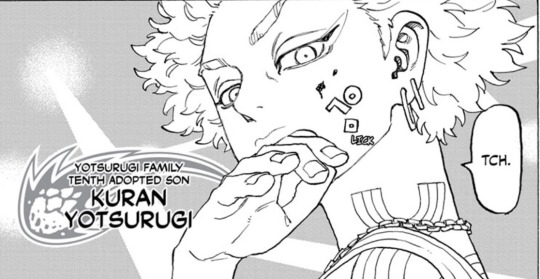
Religion - Buddhism/Asura
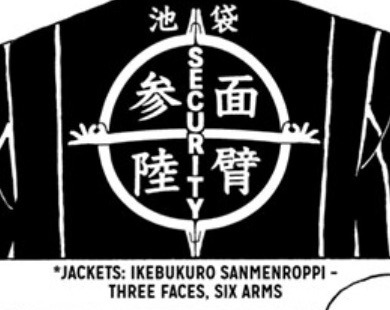
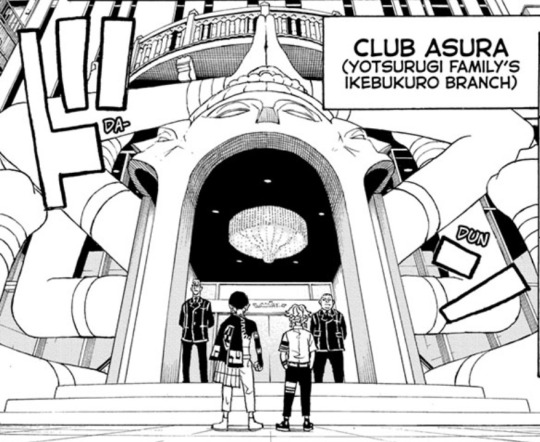

Both Kuran and Kou have half of Asura tattooed on their forearms. The Sanmenroppi security branch’s logo and Ikebukuro headquarters are also a resemblance of the demigod.
I did some research, and came across this line of text I find very interesting, regarding Kou, and the inferiority he feels when compared to others.
In the earliest Vedic literature, all supernatural beings are called Devas and Asuras. Each Asura and Deva emerges from the same father, share the same residence, eat together the same food and drinks, and have innate potential, knowledge and special powers in Hindu mythology; the only thing that distinguishes "Asura who become Deva" from "Asura who remain Asura" is intent, action and choices they make in their mythic lives.
"Asuras who remain Asura" share the character of powerful beings obsessed with their craving for wealth, ego, anger, unprincipled nature, force, and violence. Further, in Hindu mythology, when they lose, miss, or don't get what they want (because they were distracted by their cravings) the "Asuras who remain Asuras" question, challenge, and attack the "Asuras who became Devas" to loot a portion of what the Devas have and the Asuras do not.
In Buddhist mythology, the Asuras are said to experience a much more pleasurable life than humans, but they are plagued by envy for the Devas, whom they can see just as animals perceive humans.
Take that text of information as you will. I hope you can understand my point without me having to explain further than this lol.
Does Kuran have a Astro?
Personally, I’m thinking he either does not have an Astro, or he doesn’t want to admit he has one.
Astros are given to people who held onto something precious, and made a wish. Kuran doesn’t really seem like the type of person who makes wishes, or gives into sentimental notions like that.
If he does have an Astro, he’s probably keeping it a secret so he doesn’t have to use it on Kou. When Kou challenged Kuran to fight for branch leader, had he known Kuran also had an Astro, he would surely make him use it so he could win in a ‘fair fight’.
I definitely think Kuran let Kou win for multiple reasons. 1, he doesn’t want to seriously hurt his younger brother, he’s too kind for that. 2, as an older brother, he’s kind of just letting Kou do and have whatever he wants for the time being. More below lol.
Relationship between Kou/Kuran
As a big brother, I think Kuran feels it’s his role to support his younger brothers, not fight with them.
He doesn’t think it’s right to ‘put them in their place’ or anything like that. Instead, he thinks it’s better if he supports them, forgives their misdeeds, and protects them if they get in over their heads. Even when Kou says dehumanizing things, like calling Kuran “my little security robot.”/ treating him like a winnable object; Kuran doesn’t take it personally, since Kou finally has confidence in himself …
I think Kuran might spoil Kou because he knows how insecure Kou is in being the youngest sibling, with nothing to his name.
Kuran understands that Kou is becoming power hungry, but he doesn’t see a harm in it as long as he is still around to pick up after the messes.
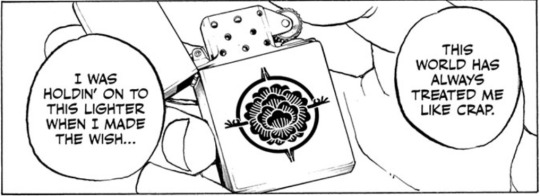
The Lighter that Kou made his wish with. This can be speculated as headcanon now, but I think Kuran gave Kou this lighter, encouraging him not to give up on becoming stronger, even if he feels weak now. It just seems like a good older brother thing that Kuran would say to ease his little brother’s insecurities.
And just as he said, Kou did become stronger. So to encourage Kou into realizing he isn’t the same weakling he was before, Kuran purposefully lost to him. Beating Kou would only crush his confidence and put Kou right back to square one:( as a supportive older brother, Kuran simply can’t do that.
That was pretty much the bulk of what I wanted to say about the most recent chapter; if anyone would like to add anything, go ahead! ^.^
#Negai no Astro#negai no astro spoilers#nna#astro royale#astro royale spoilers#yotsurugi kuran#kuran yotsurugi#Yotsurugi Kou#kou yotsurugi#Yotsurugi#astro royale kuran#Astro royale Kou#negai no astro kuran#Negai no Astro Kou#nna headcanons#negai no astro headcanons#Kuran headcanons#kou headcanons
105 notes
·
View notes
Text
I’m only getting around to posting about it now but as soon as Ankarna’s name was said in episode 11 I immediately started looking up to the origin and roots of it (because I’m a massive nerd) and I found some fascinating things. These won’t be particularly organized so enjoy my ramblings
So first things first I looked up just Ankarna and found out that it’s the name of a nature reserve in Madagascar which, while interesting, isn’t particularly relevant or helpful.
So after that I tried looking just just Karna, since the A seemed like it might have been added AND THIS IS WHERE IT GETS FUN.
So Karna is the name of the demigod featured in the Hindu epic Mahabharata. In it, he’s the son of the SUN GOD Surya and princess Kunti, which makes him royal too (that part isn’t super relevant but I do find it fun). There’s more to the epic with a few war stories and lots and lots of family drama, but in general he’s seen as symbol as someone who is rejected by those who should love him, but do not. Which feels incredibly relevant to the whole idea of a neglected god, of an idea that should have a following but doesn’t.
But yeah I find it extra fun considering how many connections Ankarna has to summer and the sun, being that his counterpart in the real world was a demigod of the sun.
One more fun detail is that one of his names (he’s referred to as a bunch of em) is Vrisha, which means “one who is truthful and keeps his vows” which could be nothing but j find interesting.
78 notes
·
View notes
Text
I think I need to make it clear for many Vaishnav (looking especially at you, ISKON) Hindu extremists (and even many Shaivites) that ya'll can have your sects and your beliefs as Vishnu or Shiva as your supreme lords. I don't have an issue with that.
But when you try to say that this is the ONLY truth about the Vedic religion (I'm not using Hinduism here because it doesn't sum up the pantheon as much as the ''Vedic" word does, despite the term being associated with the Vedas, and yes we need to come up with a better word that comprises this entire pantheon as a whole), that's when I have a problem, because that is definitely NOT the entire pantheon.
Do not spread the beliefs of your sect as the ONLY canon belief and don't speak for the people who don't fall under this category. I have seen this in all of social media and it pains me how much of a linear pantheon this once oh-so flexible culture has become.
Yes the concept of Prajapati and the Supreme being has existed since the Vedas. But when you say that Vishnu and Shiva are somehow superior to other gods as the ONLY CANONICAL BELIEF, that just flips me off, and I'm gonna call it out.
How dare you forget the four Vedas, that had no mention of such an idea? This might tick some people off but Indra, Agni, Rudra (which later became synonymous with Shiva, but is a whole different deity), Mitra, Varuna, Vayu and a few other Gods were just as much powerful as Vishnu or Shiva, if not more. This is ANOTHER canonical truth that these extremists (again, somehow mostly Vaishnav) are denying.
Ancient pantheons weren't some linear path with just one canon event. These were their own multiverses of a plethora of VARIOUS canon events, myths and legends. So stop making the Vedic religion a linear, rigid pantheon. Remember? It's not an organized religion. There can be SEVERAL canonical truths. Like I definitely understand that a religion/culture changes overtime. It evolves. Fine. Vishnu is the supreme God now, fine. But you can't deny the history. The Vedas that didn't canonize this. Are you gonna say that these Vedas, that came BEFORE this Vishnu/Shiva being the considered the supreme lord(s), were wrong? I hope not lol.
Besides, I'm not even gonna get into ISKON. They have regarded anyone that's not Vishnu as a demigod, which is ABSOLUTELY VILE AND DISRESPECTFUL. Do they even KNOW what a demigod is??? FUCK NO. They don't. They just like to use that word to inferiorize other deities, due to their unhealthy and toxic obsession with Vishnu, who doesn't deserve it. On top of that they have claimed that worshipping such gods will not lead you to eternal peace, or that it's somehow wrong. Ah yes. Gotta love gatekeeping and toxic cult fan behavior. Call me rude but if you disrespect a GOD (yes, Indra, Mitra, Varuna and others are ALSO GODS, FYI) is WILD, and they should be called out for it. (Some Shaivites have done the same in case of Shiva, and they need to be similarly called out.)
In conclusion, worship whoever tf you want, but remember that theologically, and even historically, there can be more than one canonical story. It really depends on which sect/region you belong to. You CAN be a polytheist. Idk why Hindus these days are inadvertently trying to appeal to the monotheistic pantheons so much, to the point that they have an internal dislike for polytheism, which they're not aware of, but it shows when they speak up.
This pantheon (like every other pagan pantheon back in the day) is very broad. Remember that. And it's very flexible. So let it be like that, and stop gatekeeping it and having a war between who supreme Lord is. I'll stop my yapping here. But I hope people understand this. Cuz damn.
#Im sorry but this needed to be addressed#this whole thing has had been a pain in my ass#anyways#hindu mythology#hinduism#hindu myths#hindu gods#vishnu#shiva#desiblr#hindu#hindublr#paganblr#paganism#desi tumblr#vedic culture#vedic mythology#vedic literature#hindu religion
123 notes
·
View notes
Text
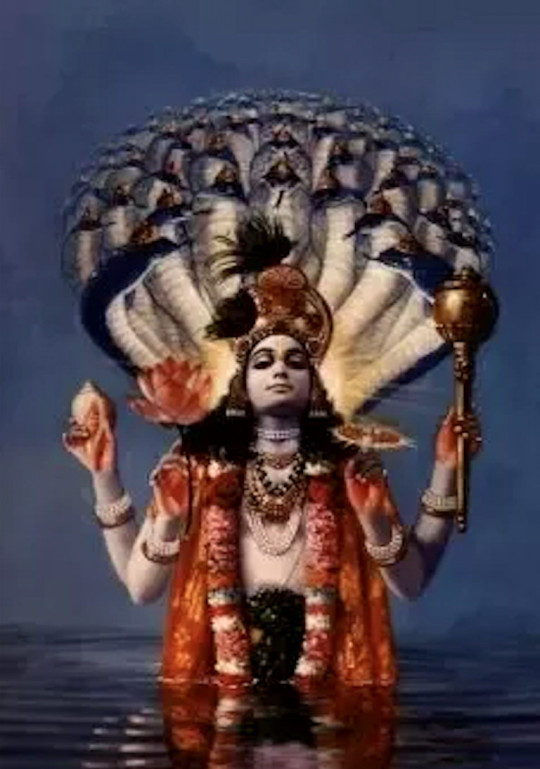
Legends of the humanoids
Reptilian humanoids (8)
Naga – Half-human, half-serpent divinities living in the underworld (Patala)
Name of a Hindu deity. Translated from Chinese as 'dragon', but originally refers to a snake, especially a cobra, as opposed to a Chinese dragon. It is assumed that snake worship already existed in the Indus civilisation. The Aryans gradually accepted the ancient worship of the snake-god and came to regard it as one of the demigods.
In Hindu literature, the Nagas, or snake people, are said to dwell in the subterranean world called Pātāla. Vāsuki and other dragon kings rule that world. At the lowest level of Pātāla dwells the primordial serpent (Shesha) Ananta, whose head supports the weight of the whole world. Nagas often appear in literary works in human form, and the dragon's daughter was described as having a very beautiful appearance.
Nagas are often mentioned in Buddhist scriptures and are one of the Eight Divisions of the Heavenly Dragon. Mahoraga, also belonging to the Eight Divisions, refers to giant serpents, but seems to refer to pythons and other serpents. In Nagaland, near the Myanmar border, there is a tribe called the Naga people, who claim to be descendants of the Naga and have preserved their own customs.
The Naga is worshipped in various Asian religious traditions and rituals dedicated to this supernatural being have been practised throughout South Asia for at least 2,000 years. They are principally depicted in three forms: as entirely human with snakes on the heads and necks, as common serpents, or as half-human, half-snake beings in Hinduism, Buddhism, and Jainism.
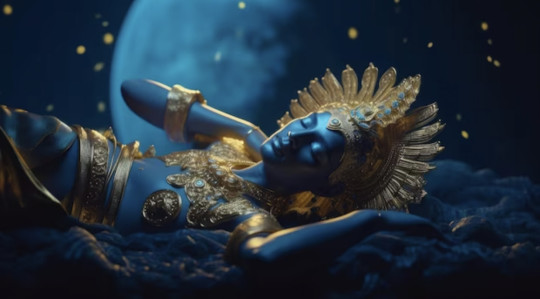
伝説のヒューマノイドたち
ヒト型爬虫類 (8)
ナーガ 〜 冥界 (パーターラ) に住む半人半蛇の神々
ヒンドゥー教の神名。「竜」と漢訳されたが,本来は中国の竜とは異なり,蛇,とくにコブラのことである。蛇神崇拝はすでにインダス文明において存在したと推測される。アーリヤ人は古来より行われた蛇神崇拝をしだいに受け入れ,半神の一つとみなすようになった。
ヒンドゥー教の文献では,ナーガすなわち蛇族は,パーターラと呼ばれる地底界に住むとされる。ヴァースキ (和修吉) その他の竜��がその世界を統治している。パーターラの最下層に原初の蛇 (梵: シェーシャ: 難陀竜王) アナンタが住み,その頭で全世界の重みを支えている。ナーガはしばしば人間の姿で文学作品に登場し,竜の娘は非常に美しい容姿をしているとされた。
ナーガは仏典においてもよく言及され,天竜八部衆の一つである。同じく八部衆に属する摩睺羅伽 (マホーラガ) は大蛇のことであるが,ニシキヘビなどの大蛇を指すようである。ミャンマー国境に近いナガランドには,ナガ族という種族が住んでいて,ナーガの末裔と称し,独自の習俗を維持している。
アジアのさまざまな宗教伝統においてナーガは崇拝され、この超自然的な存在に捧げる儀式は、少なくとも2,000年前から南アジア全域で行われてきた。ヒンドゥー教、仏教、ジャイナ教では、頭と首に蛇を持つ完全な人間、一般的な蛇、あるいは半人半蛇の存在として描かれている。
#naga#hindu gods#snake god#patala#underworld#cobra#snake people#dragon#humanoids#legendary creatures#hybrids#hybrid beasts#cryptids#therianthropy#legend#mythology#folklore#nature#art
97 notes
·
View notes
Text

Cycle Of Samsara
Six Realms
Six States of Existence Six Roads of Reincarnation Six Paths of Transmigration Six Realms of Samsara Six Karmic Realms of Rebirth Six Directions of Reincarnation Six Destinies
Wheel of Life
Six Paths (Jp. = Rokudō 六道 or Rokudō-rinne 六道輪廻 or Mutsu no Sekai 六つの世界). Buddhist concept stemming from Hindu philosophies. Commonly translated in English as the “Six Realms of Karmic Rebirth.”
Long before Buddhism's introduction to India, Hindu (Brahman) beliefs and traditions held sway. One important concept was "transmigration," more commonly known in the West as "reincarnation." It holds that all living things die and are reborn again. Your rebirth into the next life will be based on your behavior in your past life. This rebirth occurs again and again. When Buddhism emerged in India around 500 BC, it too stressed this Hindu belief in transmigration, one that still plays a major role in modern Buddhist philosophy. The modern Buddhist concept of Karma is also a byproduct of ancient Hindu beliefs in transmigration and reincarnation.
Among Buddhists, all living beings are born into one of the six states of existence (Samsara in Sanskrit, the cycle of life and death). All are trapped in this wheel of life, as the Tibetans call it. All beings within the six realms are doomed to death and rebirth in a recurring cycle over countless ages -- unless they can break free from desire and attain enlightenment. Further, upon death, all beings are reborn into a lower or a higher realm depending on their actions while still alive. This involves the concept of Karma and Karmic Retribution. The lowest three states are called the three evil paths, or three bad states. The Japanese spellings of all six, plus brief descriptions, are shown below:
1.Beings in Hell. Naraka-gati in Sanskrit. Jigokudō 地獄道 in Japanese. The lowest and worst realm, wracked by torture and characterized by aggression.
2.Hungry Ghosts. Preta-gati in Sanskrit. Gakidō 餓鬼道 in Japanese. The realm of hungry spirits; characterized by great craving and eternal starvation; see below photo/link for “Scroll of the Hungry Ghosts” (Gaki Zōshi 餓鬼草紙)
3.Animals. Tiryagyoni-gati in Sanskrit. Chikushōdō 畜生道 in Japanese. The realm of animals and livestock, characterized by stupidity and servitude.
4.Asura. Asura-gati in Sanskrit. Ashuradō 阿修羅道 in Japanese. The realm of anger, jealousy, and constant war; the Asura (Ashura) are demigods, semi-blessed beings; they are powerful, fierce and quarrelsome; like humans, they are partly good and partly evil. See Hachi Bushu (8 Legions) for details.
5.Humans. Manusya-gati in Sanskrit. Nindō 人道 in Japanese. The human realm; beings who are both good and evil; enlightenment is within their grasp, yet most are blinded and consumed by their desires.
6.Deva. Deva-gati in Sanskrit. Tendō 天道 in Japanese. The realm of heavenly beings filled with pleasure; the deva hold godlike powers; some reign over celestial kingdoms; most live in delightful happiness and splendor; they live for countless ages, but even the Deva belong to the world of suffering (samsara) -- for their powers blind them to the world of suffering and fill them with pride -- and thus even the Deva grow old and die; some say that because their pleasure is greatest, so too is their misery.
34 notes
·
View notes
Note
(Super long bc I kinda Info dumped sorry)
If you didn’t mind could you maybe talk about what demigods look like/cryptid demigod hcs
I’m probably wording this wrong but I saw a tiktok saying that kids of gods would have cryptid features for example children of hades or underworld gods in general having vampire features, children of sea gods having scales or webbed fingers, maybe children of Zeus or wind gods get feathers,children of Athena can do 360 head turns like owls, Hecate kids having a visible functioning third eye on their forehead that shows them spirits(and probably vampire features Hecate does do necromancy stuff), Hermes kids getting winged feet, children of Apollo having glowing eyes (I think this is somewhat canon) tbh the list goes on
It’s reasonable to think that demigods look somewhat uncanny they are literally half god and it would probably be covered by the mist to mortals anyways
Even if you don’t wanna do a full series on this I’m just curious to ur opinion on it and ideas you have for other gods
Alright, here’s my own take if we’re going off the Greek demigods having uncanny features:
Zeus: The children could have feathers but also considering them being like the air and clouds. Like their presence can be loud and forceful like high winds or practically invisible like the air around us, or how they seem to float as they walk, their feet never really touching the ground. However, when they get angry, their form shifts and they become this angry grey, stormy cloud, crackling lightning and thunder, their voice distorting like booming thunder as their presence whips around you and threatens to tear you apart. Their hands when they touch you spark and electrocute you, and you can smell and taste the ozone around them. They look down at you with eyes like an eagle.
Poseidon: I would wager they have a sleek appearance to them and everything seems okay. So maybe when they smile, you see some unnervingly sharp teeth like a shark. However, when they enter the water, your eyes can't tell if the water is distorting their shape, but you swear you see something else that makes you remember that we know more about space, then our own ocean; making you both amazed and afraid at what the abyss contain…or don't allow you to see because they won't let you resurface at all.
Hecate: While a third eye is cool, that’s more of an Asian mythological feature (I.e. Hindu, Buddhism, Taoism), however, I can see them having three faces that they can change according to that face’s personality, or true to Hecate’s mythos, where Hecate changes forms from a young girl to an oldy lady according to the time of day, their children faces/personality changes according to the time of day. In a moment of peak battle or power, all three faces appear all at once. The Vampiric features also work as well in this case, but you could also go with something ghoulish or ghostly. From the distance, their appearance to you is half invisible like a rolling mist. Another trait that a child of Hecate could have is serpentine qualities, relating them to Lamia, who has a connection with the goddess. So imagine a child of Hecate with skins with the scales of a snake, a forked tongue, and limbs that move too fluidly in a way that makes you think they don’t have normal human bones.
Hades: we already see references to it with Nico, but the ghostly, pale appearance would be made more true. Representing the domain of death, they would have cold skin, their eyes are dark like shadows, Or part of the Riches of his domain, you'll see how their eyes twinkle like jewels gold or their teeth, nails shimmer like diamonds. They seem alive to you but if you watch them carefully, you notice their skins shimmer as if their see-through or made out of precious gems, but then you realise, you really haven't seen them breath. Not in the way of the living. Their chests don't move unconscious and almost seem forced, like they have to remember to move their chests up and down. In fact you've seen them stand way too still, with chests freezing yet they're still moving.
Athena: I think her kids not only can turn their necks pretty much around like an owl, but have you considered they really have good hearing, and moving practically invisible? There's a reason why owls are considered the silent hunters/death. Their grey eyes looking wide and bright at you, but as you move, you notice their eyes following you as if you're a mouse moving among a field. Their heads and neck tilting just so that makes your own neck feel severed.
Demeter: Ever heard the metaphor “Hair like corn”? Each child of demeter has qualities that reflect nature, crops, or anything to do with plant life. When they laugh, it either sounds like branches brushing against each other from the wind or the sound of wood creaking and cracking as the bark and flesh of the wood breaking. Or when you see a child of Demeter fight during the wars and you see their blood or flesh fly. When it lands on the ground, you watch as it sprouts into another version of themselves like fungi; you realise if the child of Demeter you've been talking to is the original or just another body of them with the same mind and soul?
Aphrodite: We know Aphrodite's appearance will reflect what the person's ideal version of beauty or who they love is reflected off her. Now imagine her kids having the same thing, their faces resembling everyone's love, preference, their ideal features (button nose, thin lips), but when you come to actually describing their entire face, you suddenly can't. You have an idea of their features but they're in fragments. You try to piece them together and form their face but you can't. You can't remember their faces at all. You start to think you don't know their face at all, you never have, and they're just a mirage in your mind. You don't remember their faces because you can't. You've never seen them, have you?
Ares: Out of them all, they seem the most human-like. War and violence is a part of human nature and it's reflected in them. They hold qualities that make you sweat and stiffen, the way they look at you makes you want to either fight or flight. A side of humanity you don't want to admit that is in our nature and life.
Dionysus: There's a quality to them that seems a bit off to you, but you can't help getting drawn in. Their eyes are maniacal and don't stare in the eyes too long or you find your mind drifting off. Or how they move like a jaguar, their appearance alluring but very deadly as they stalk towards you. Nonetheless, your eyes will deceive you as you try to look at them, their forms not exactly what they seem to be and if you try to dissect what they look like, you’re not going to like what you see.
Hermes: Their feet may have wings that allow them to fly and go about speeds. However, much like the Aphrodite children, you see the faces of a traveller. They've been to places and seen things you haven't seen before, but when you try to think of their faces, you can't remember. They made an impression on you yes, but when you try to remember their features, you can't really remember and they are only a figment in your memory. Yet you can’t forget them or their sweet, honey layered and silver tongued words, even if you know its a lie, you find yourself believing in them and take their words as the truth.
Hephaestus: The children of Hephaestus’ eyes burn and glow with hot coals, flaming hot. Their features are almost sculpted like marble statues, both soft yet rigid. Their veins underneath their skin have a thin glow of heat like the veins of a volcano as they bend the physical shape of something in something else. A limb of theirs moves rather rigidly, like it was a limp but as it moves, you are reminded of the joint of a machine, moving in a certain way that isn’t like a muscle. When their skin is reflecting the heat of the forge, you are reminded that their skin looks like stone or metal.
Apollo: We already know about the glowing eyes part, but I wanna say there’s a bit more to that. How light follows them, how they embody it. You can see them but you can’t stare directly at them for too long before your eyes start to burn like staring directly into a lightbulb. Their form seems to shimmer and bend with the light, before you realise you may not be able to touch them more than you can touch the sunlight. Then you also start to realise the shadows around them seem more darker, more of a void then you thought it could be, moving, swirling beneath their feet. As you take notice of the shadows behind them, how it seems to wrap around them like a second skin, the shadow then moves on its own, differently from it’s host, as it raises its finger over where the mouth should be, before you see it actually smile. You may not be able to touch the light and shadows, but it can certainly touch you, prying your darkest truths and secrets from your own shadow betraying you. You learn that the children of Apollo don’t naturally have shadows because they’re made out of light, so where is their darkness?
Going off a bit more of the whole concept though: It’s not the first time nor the last time someone who has those kinds of ideas as humans do. The only reason the Greek and Roman demigods have ‘human’ features is because of how the gods are perceived, where in Ancient Greek people believed the Gods looked like regular mortals, but were absolutely perfect in their appearance as they were above mortals and their features reflect peak perfection of our human appearance, and we cannot perceive their true form because it is outside of our mortal realm. I believe that’s why the gods turning into their true form is deadly to mortals for that reason.
So the greek/roman demigods would have the godly qualities to them, that are still mortal but just a little bit different, a little out of this world. We actually see Rick Riodan reference these features in the book like Percy’s Sea Green eyes or Thalia and Jason’s Electric Blue eyes. Those weren’t metaphors or similes. They just lean more towards beyond human then cryptid realm.
However, it wouldn’t be unusual to attach some non-human features to the gods as we constantly attach their symbols to them. Specifically the animal parts relating to the gods, it’s one of the reasons Egyptian gods are depicted with animal features; as the animal parts to represent their personalities or specific traits that were important to their purpose. For example, Anubis the God of Death is depicted with the head of a jackal as the animal was associated with death in ancient Egypt. So if these Egyptians gods had demigods, we can only assume they would have these features too.
I believe in the Riordan verse, there are the Mayan gods and the Mayan demigods, Godborns, are the opposite of their Greek/Roman counterparts where the Godborns have a sort of physical handicap, disability, or some medical or mental issue. This is because people believed the blood of humans and the supernaturals were never meant to be mixed.
So go have one with your ideas! Be wild! Test the realm between mortals and the supernatural.
#percy jackson and the olympians imagines#pjo#demigod h/cs#demigod headcanons#demigod imagines#pjo imagine#pjo imagines#percy jackon and the olympians#pjo fandom#anon ask#ask box#ask me stuff#ask questions#asks#scribe's note#greek gods#cryptid#I guess???
72 notes
·
View notes
Note
If you defeat Messmer the hornsent will say that the snake emerging from him is a "sublime scene" or something similar i wonder is the snake is something that has been considered as holy/ divine by the hornsent. + What is the deal with abyss serpent? Marika was so afraid of it she banished her son for it, i know gameplay doesn't necessarily equal lore but the Abyssal serpent doesn't seem to be that dangerous
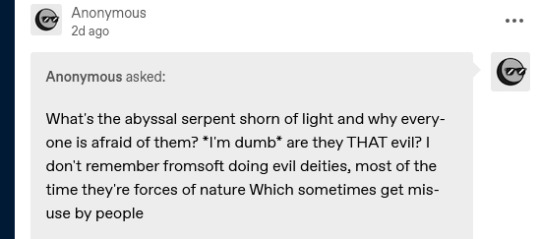
;-; This is like the third time I forget to answer an ask and only remember about it when I get a similar one I am so sorry dhfhsd
As for the Vengeance-Seeking Hornsent, I think it was either a sarcasm or expression of satisfaction to see how monstrous Messmer was with his own eyes, given the place of that line in the full dialogue:
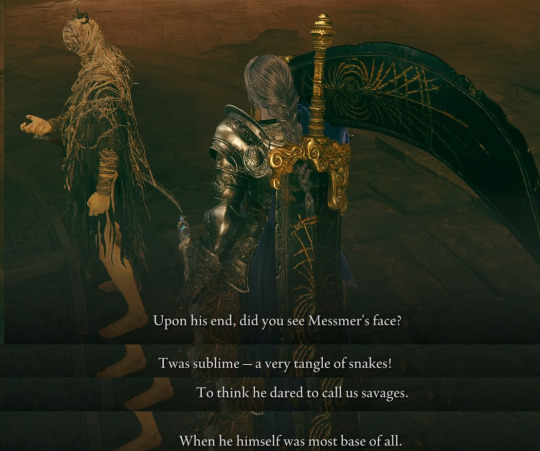
That being said, it doesn't exclude seeing the Base Serpent as divine either! It could always be sort of both, a bit like how Fell God is both revered and feared/dreaded!
I actually touched upon the 'Abyss' and Base Serpent in my post diving into what happened with Romina recently ( x ), so for the starters I'll copy a small bit from it to prevent the confusion! Ymir states that Marika's roots are 'in madness' and flowers on the painting of Midra's Manse in its past are the same as in Shaman's Village, but just in case the 'abysses' are not the same:
I need to add that Abyss of the serpent plaguing Messmer and Abyss of the woods tormented by Frenzy are different things though; whereas serpent’s Abyss is 深淵 meaning literally an abyss, Woods’ Abyss is 奈落 that means Naraka (Hindu Hell)! His serpent is AKTUALY named Base Serpent, but he refers the 'Abyss’ in his Stage 2 transition: '光無き、深淵の蛇が’. ( x ) In fact, his dialogue in both English and Japanese original suggests the 'Abyss’ is a PLACE, where Base Serpent comes from! The mysterious space without light!
So, the Abyss is the place without light, the 'hole' within what Greater Will entails and embraces:
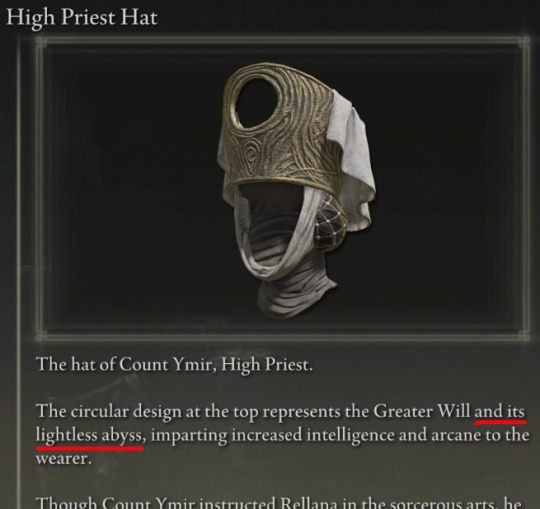
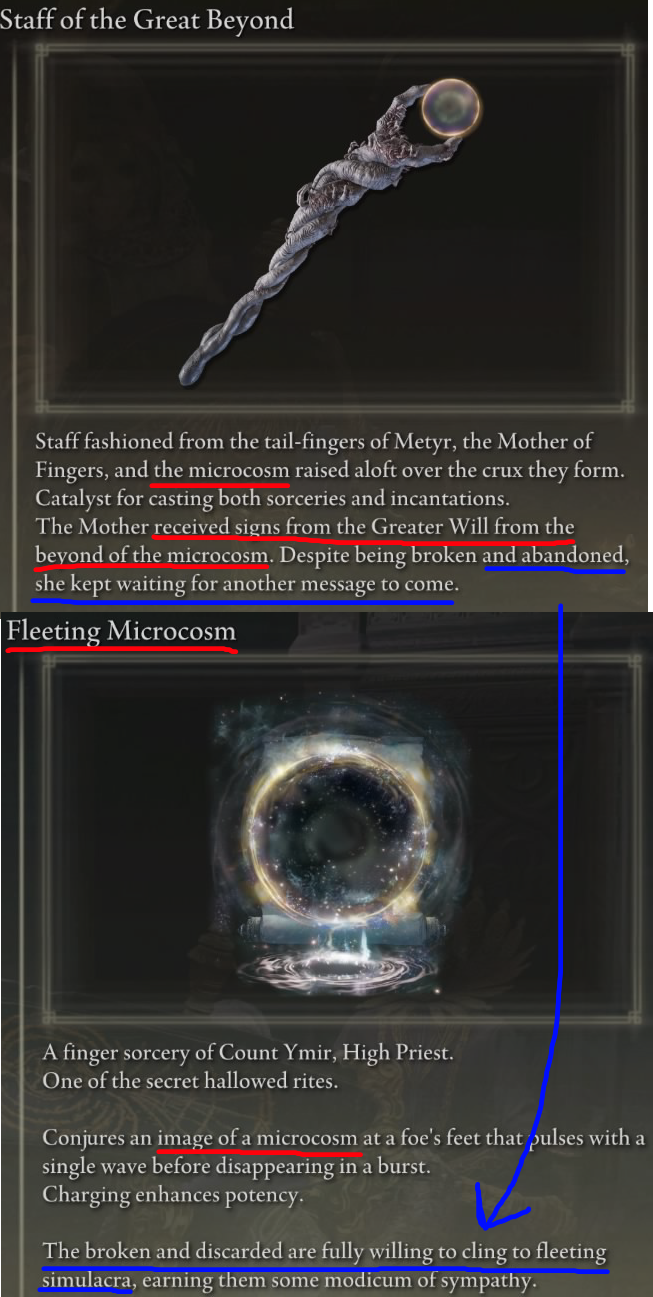
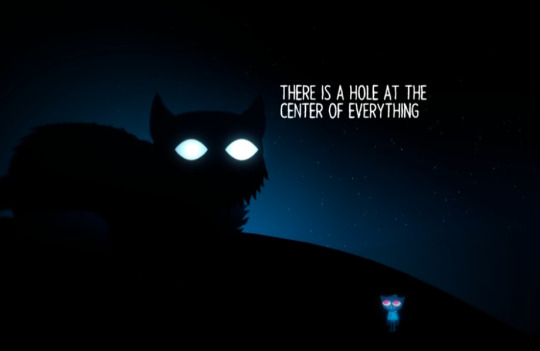
@val-of-the-north also says that it further proves that Frenzied Flame is basically a "sibling" or the second side of the same coin, as its "face" likewise has a black hole at the centre!
Elden Ring itself is light, the blue stars controlling humans and the amber stars controlling Demigods are light, Erdtree and the greater tree predating it are light... Light is the essence of life and the orders, not even just the Golden Order however it has been THE order for a while! Messmer and Queelign repeat that all "lightless" should burn in his flames, and they are doing it for the sake of Marika's beliefs. So, the 'lightless' part of the issue is very important! It is fearsome as something they cannot fully control, it is antithesis for life the way they know it and they are used to! At the same time, no longer seeing the light is something grace-given lifeforms fear (Iris of Occultation)!
However, another, and arguably more important aspect of why Base Serpent is something feared, is Marika's fear of fire! For one, she went at war with the Fire Giants because they might have burnt her precious Erdtree, and she'd lost everything again:
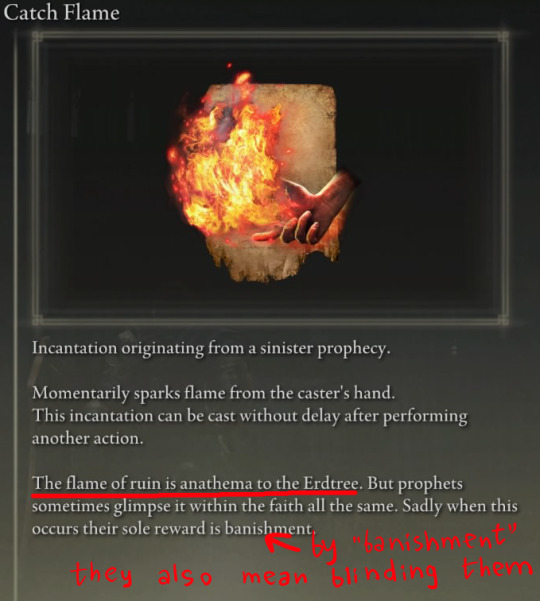

(+ Also worth to note that the Fire Monks that peer into flame and go 'hmmm actually..... 👀' and get blinded discover the Bloodstar, and Alberich who did the same by blinding self is "heretical" sorcerer! That's why I think Lightless Abyss is not empty but various horrors live in it, and Formless Mother appeared from it too! Again, not the point of this post as I already talked about it in Romina post I linked earlier)
Another precedent was burying the Nomads because Shabriri said that they were worshipping Frenzied Flame:

(From the video that recovers Kale's quest ( x ))
There is also this:
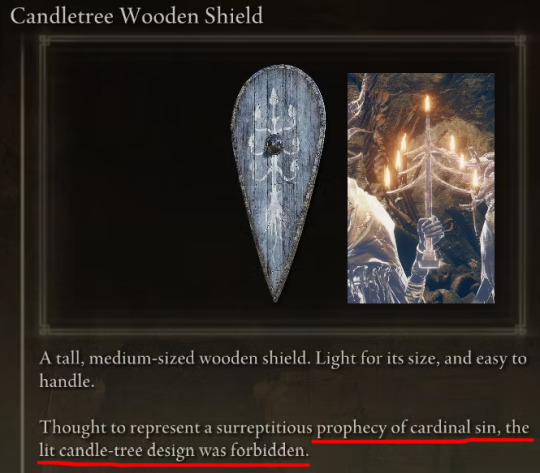
I assume the prophesy has to come from the Hornsent in some capacity! Like maybe when the Two Fingers gave her aid to ascend to Godhood, she already knew from the Greater Will (?) that she won't rule forever! Ranni and Miquella both refer to the ages they want as 'thousand years voyage', so perhaps any era being set on the timer is a common sentiment! The Age of the Erdtree logically must end with the Erdtree being burnt, of course, and there is Empyrean Grandam who is a Hornsent..
I am yet not sure whether Melina is Gloam-Eyed Queen "killed" and reborn, making her instead an adopted daughter to keep her fire under control or she is a real daughter but stripped from her true power and body because of the fear of fire or both! I just think that back then, looooong before Marika could've predicted the thorns created by Radagon needed to be burnt, Melina being so "downgraded" for someone who is her daughter also had to do with the fire!
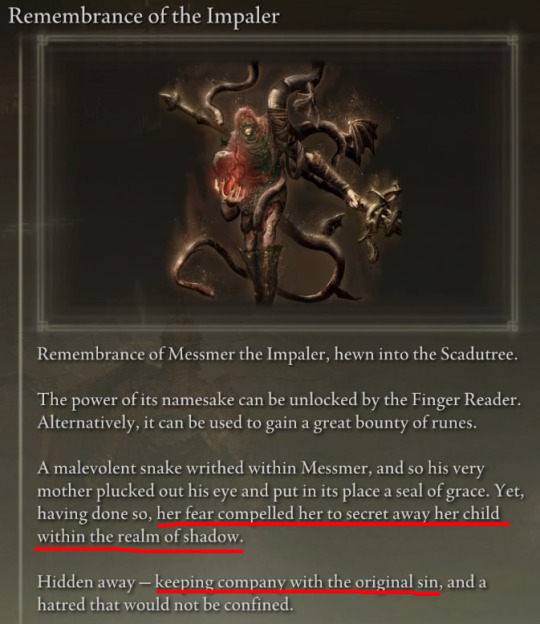
Messmer getting discarded is just an extension of it. Or her not willing to deal with the fear of the Erdtree getting potentially burnt because of the Base Serpent's fire!
As for whether it is an "evil" power? I likewise don't believe so! Fromsoft always makes 'eldrich' Gods either powers of nature or just creatures far from humans' concepts that just vibe! It is Gods who are basically just humans with too much power who can be evil and cause havoc, like Gwyn and his family and Marika and her family! Base Serpent is not "evil", it is a force of nature; necessary inferno to burn the nature, so it doesn't rot and later can be born anew from the ruins! INRI means 'Iesvs Nazarenvs Rex Ivdæorvm', but it also has an occult interpretation: 'Ignis Natura Renovatur Integram' ('All nature is regenerated by fire')! I believe Messmer has to be not only Marika's firstborn but also have special position compared to other Demigods, because he is "necessary" evil. A "promised" end to Marika's reign, who maybe is not even cursed but rather hard-coded to be this way by the Greater Will itself.. because Base Serpent comes from the Abyss inside it, Fell God on the other hand is not connected with serpentine stuff! When Messmer gets rid of Marika's eye, he promises oblivion that you and him will fall into, which again refers to the lightless Abyss.
The only evidence to Base Serpent being dangerous is that it has to be kept in check by the Winged Serpent:
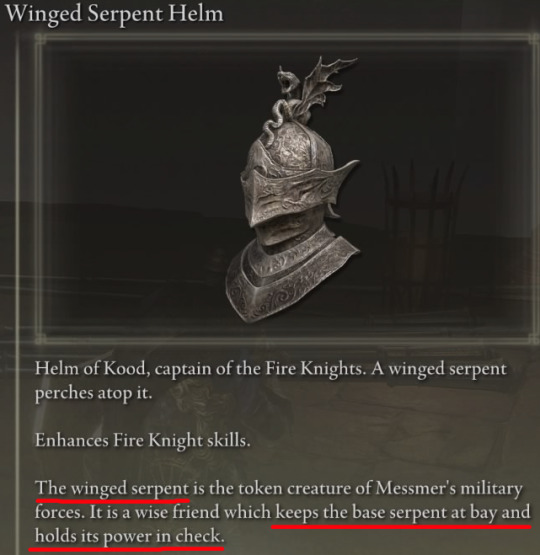
It is not inherently evil, but it IS chaotic! It would not know when or where to stop or how to take the pace, much like the element of fire itself who simply burns whatever it meets on the way! And yet again, how "evil" can a force of nature be? It is "evil" for those who don't want to burn, but that's it and it is not a moral value but a (reasonable) fear! Burning things needs to be smart and balanced, or else it will just be 'Frenzied Flame at home'!
_____________________
Anyways thank you for asking so much!! I love discussing this particular topic a lot actually! +I assume Eiglay is a similar kind of serpent, but specifically promised death of Gods (maybe Outer Gods specifically, even) rather than Demigods and various things mortals built and birthed! Maybe she is even a sister of Base Serpent of sorts
#elden ring#ask replies#messmer the impaler#base serpent#elden ring theory#elden ring observation#screenshots#elden ring reference
40 notes
·
View notes
Note
behnchod, madarchod, baanki maagi,, bokachoda, you fucking hoe, rot in fucking hell, you brother fucker, motherfucker, gaandu, randi, saala, harami, bohot tez samajh ta hai apne aap ko? Bhosdika, bara, saale gaand choos tu apna, kindly f yourself
Tere krishna ne terko gaali dena sikhaya hai!?!! Where are hindu women's SANSKAAR??? Tum aurte khud ko mhan samjhte ho i guess u r bhramin that's why u have superiority complex. WhatsApp university se padhna chod or real world me aa jaa
Let's start with the biggest issue I have with scriptures in Hinduism and the casual misogynistic tone in the marriage department.
Ramacharitmanas 3.4.4 - "A woman who treats her husband with disrespect even though he is old, sick, dull-headed, *wrathful* or *most wretched*, she shall suffer various torments in hell (The abode of Yama)"
Vishnusmriti 24.41 -A damsel whose menses begin to appear (while she is living) at her father's house, before she has been betrothed to a man, has to be considered as a degraded woman: by taking her (without the consent of her kinsmen) a man commits no wrong.
Valmiki Ramayana 2/24/20 - - Ram said \*"As long as a woman is alive, her husband is her god and master to her"\*
Valmiki Ramayana 2/24/25 - "Even if a woman is interested in religious vows and fastings, in addition to being the best of the excellent; if she doesn't obey her husband, she will become ill-fated!!"
Matsya Purana 154.166 - "The husband even if poor, illiterate, and devood of fortune, is like a god to his wife."Mahabharata
Anushasana Parva 146.55 - Husband alone is the God for women
Srimad Bhagwatam 6/18/33-36 - "A husband is the supreme deity for the woman. The Supreme, Lord Vasudeva is situated in everyone's heart and is worshipped through the various names and forms of the demigods by fritive workers. Similarly, a husband represents the Lord as the object of worship for a woman. A wife should be chaste and obey all orders of her husband. She should very devoutly worship her husband as a representative of Vasudeva."
Sage Ashtavakra said:Women can never be their own mistresses. This is the opinion of the Creator himself, viz., that a woman never deserves to be independent. There is not a single woman in the three worlds that deserves to be regarded as the mistress of her own self. The father protects her while she is a maiden. The husband protects her while she is in youth. Sons protect her when she is aged. Women can never be independent as long as they live.
Oh ho! Now you are asking our SANSKAAR!? Ram sikhate hai ki maryada mein rehte kaise hai.
Krishna sikhate hai ki maryada mein rakhte kaise hai.
Listen you motherfucker. I don't need to be educated on this. You dare question our SANSKAAR? WE became like THIS to PROTECT OURSELVES. WE learnt SWEAR WORDS BECAUSE MEN STARTED TO USE THEM FIRST!!!
And women can never be independent, eh? Look around the fucking world will you, ot do you use braille to type?
First you make us like this and now question US? Atleast hum aurate apne aapko mahan sigma male to nhi smjh ti, na? Aurato ko tum log hamesha 'women ☕️' karte rehte ho, unko disrespect karte ho, rapists ko support karte ho, unke saath jo unyay hota hai usko supprt karte ho, and when we stand up for ourselves, us hindu women's SANSKAAR dissappeared!? THIS is the reason why women hate men now.
Tu Insta reels se sab kuchh learn karrna band karr aur apni aakhe charo taraf ghuma, bsdk.
We can be our own mistresses, and we will be our own mistresses. Idc what anyone thinks, i stand with my opinion. Agar teri Maa nahi hoti, to tu bhi janm nhi le pata gadhere.
You know Maa Kaali as well as Maa Adi Para Shakti, right? Did they need a man to fight? Or to protect them? They protected themselves, and fought demons, monsters just to protect their children. Yea ok i agree with the 'devoted to husband' part, but if her dignity comes in question, she WILL fight back!
#hindublr#hinduphobia#bitchy anon#go to hell bitch#fuck yourself#anon asks#desiblr#gopiblr#hate on women#women
34 notes
·
View notes
Text
On Ankarna
BLeeM said the Rage God's name for the first time, and because I'm certifiably insane, my first thought was damn isn't that a Hindu demigod? Then it came to me, the Hindu epic the Mahabharata. OF WHICH KARNA IS A MAJOR PROTAGANIST AND TRAGIC HERO!!!!!
Now, I don't know who here is familliar with the plot of the Mahabharata but if you're not I'll do a quick TLDR so you don't have to google.
The epic follows two opposing factions of cousins vying for power. The crux of this power struggle centers around the line of succession. These two factions are the Pandavas and Kauravas. The Kauravas are the senior line in the order of succession but the Pandavas' eldest member is older then the Kauravas' eldest member. The whole epic details the conflict through births, deaths, and MARRIAGES. In the end, The Pandavas ascend to the throne.
This is important for us because of the demigod Karna a member of the Kauravas faction. WHO IS THE SON OF THE SUN GOD SURYA. ALSO - in Hindu his name translates to - Husk Of A Grain - . This guy is a tragic hero who falls in the final battle. He narratively is important in the epic because he serves the purpose of bringing up Dharma ( the Indian religious ideal of actions that serve the purpose of upholding life and balance in the universe ) This guy is a flawed hero that is an archetype for any protaganist that suffers through rejection as a result of circumstances, ( HIs mom Abandons his ass Moses style bc she was 16 and pregnant )
NOW, we have to connect this info to a dnd campaign on the internet.
Ankarna is a God that has lost their original domain (Summer / Sun) presumbly at the same time as their wife Cassandra (Doubt / Night). Both of them are corrupted into perversions of their original states. Cassandra becomes the Nightmare King and rules over Fear and Terror. We are currently unaware of what emotion that Ankarna started with before their shift to rage (I've seen some people on here provide very good cases for conviction). Ankarna begins as a member of the Giant Pantheon and sibling of Ruvina ( Goddess of winter and sorrow that was worshipped by Lucy Frostblade ) At some point in their story they lost this original domain and became Fiendish and was stationed over rage. We see a mirror of this relationship between Ankarna and Ruvina in Cassandra ( Night / Doubt -> Fear ) and Galicaea ( moon ). Most importantly, we know now that Sol is Cassandra and Galicaea's brother.
Reviewing these facts, I believe that there was a war over who would hold domain over the sun ( Sol or Ankarna ) and Sol won. After their loss the other gods sundered Cassandra and Ankarna names from existence to stop them from rising again and threatening their power, mirroring the central confict of the Mahabharata.
Here's an insane person theory that I also have relating to this
As previously stated, Karna means husk of grain in Hindu. Going off the idea that Ankarna was sundered from existence by Sol IT IS POSSIBLE that he was absorbed into Sol's domain and instead of morphing into something similar to the Nightmare King they Became Helio. This is a crazy idea so feel free to disregard.
51 notes
·
View notes
Text
Gender Fluidity, non-heterosexual, and gender variance behavior in mythology.
For the purpose of this thread, and keeping it short cuz even though this is my off month to finally rest from burn out, I've got publishing obligations, signings, and stuff to do -- we're keeping-- this to South Asian mythology:
I've already done a thread about third sex/intersex and trans (Hijra) in South Asian culture and the portrayals in a pop culture IP recently - Monkey Man by Dev Patel --
This is a short primer really:
Harihara - the union representing totality/oneness of all existence is the being born of the union of Shiva and Vishnu (who at prior to this morphs into Mohini, the female celestial temptress who Shiva becomes besotted with and tries to get intimate with), Vishnu changes back amidst this and the two fuse into a being. The ability of celestial beings | gods | goddesses to morph, change shape and gender in Vedic to Hindu mythology is well-established/normal. But there are many legends about Mohini, including the birth of her (Vishnu, his female avatar form being Mohini) son, Shasta, with Shiva. Mohini is also known as a femme fatale archetype, seducer, temptress, as well as someone known for destroying/seducing demons to their doom.
One thing to remember is that the Vedic religion and its stories are old, older than our records because the stories, songs, poetry of it all existed before written records and were transmitted orally. There are also varied versions of the epics, such as Tamil recountings of Mahabharata for example, in where one such example exists.
Krishna also takes the form of Mohini to marry Aravan (in Tamil) Iravan otherwise to give Aravan the chance to experience love before his death. There is a festival celebrated to this in the month of Chitrai (April/May) at the Koothandavar Temple dedicated to Iravan during which, Hijras (the third sex, transgender, intersex, and or eunuchs as well) celebrate Krishna/Mohini marrying Aravan and then mourn Aravan/Iravan's death as he sacrificed himself.
It must be noted that there is artwork and mention throughout the wide spread of Vedic upwards stories (and how many interpretations, takes, and varies stories there are) of same sex and yonic/non-vaginal sex relationships, births, and more.
There's also inter-being...?


Erotica/romance authors help me out here? Inter...celestial sex?
Apsara, devas, asura, humans, demigods. Look, lots of sex of all kind happens, and it's normal.
There's also the story of Arjuna to consider: when he refuses the seductive advances of Urvashi, she curses him to be a Klba, or member of the third gender. Later when Arjuna adopts the name of Brihannala, the curse takes effect as Arjuna dresses in women's clothing, and because of this, Arjuna is able to gain entrance to the kingdom of Virata in the Padma Purana and teach the high arts of music, singing, and dance, to the king's daughter and princess. Later, he is turned into a woman when he wishes to take part in Krishna's mystical dance which only women may attend.
Then there is Ila, a character cursed by Shiva and Parvati to change genders each month.
NOTE: there are MANY versions of the story of Ila, but it is canonical they changed gender -- known as Sudyumna as a woman, and Ila as a man.
Ilā is considered the chief progenitor of the Lunar dynasty of Indian kings – also known as the Aillas.
Continuing. In one story, Ila marries Budha (not Buddha the former king and founder of Buddhism), but Budha that is the god Mercury -- Budha is aware of Ila's origins as a man and changing status, but only marries Ila in his feminine state, and honoring that part of them as his wife and only when Ila is in that state. He does not enlighten Ila to the changing effect as each gender is unaware of the other and those lives.
The tale of Ila's transformations is told in the Puranas as well as the Indian epic poems, the Ramayana and the Mahabharata.
This is just a little thread. Anyways, I'm off now to sign nearly 2000 pages (won't finish today) and have an achey hand while I do more research and trying to improve the prose style I want for book three of Tales of Tremaine.
❤️ thank you. Remember, be kind.
#gender fluid#gender variance#genderfluid#south asian mythos#south asian mythology#third sex#intersex#gender is a social construct#gender in lore#epic poems#ramayana#mahabharata#trans representation#transgender#sudyama and Ila#pride month#trans pride#thanks for coming to my ted talk#monkey man#gods and goddesses#hindu gods#hindu mythology#vedic gods
23 notes
·
View notes